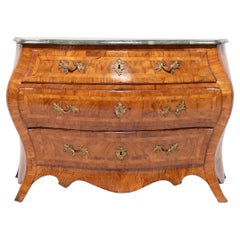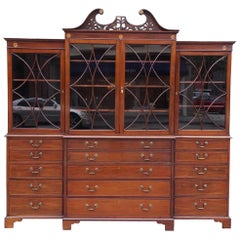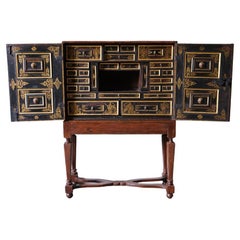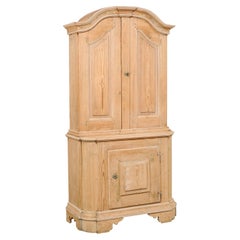Cabinets
Mid-18th Century Swedish Rococo Antique Cabinets
Brass
1990s American Modern Cabinets
Chrome
1770s English Chippendale Antique Cabinets
Brass
Late 17th Century Dutch Baroque Antique Cabinets
Metal
18th Century Swedish Rococo Antique Cabinets
Wood
Mid-18th Century German Baroque Antique Cabinets
Steel
Late 18th Century European Antique Cabinets
Wood
Late 18th Century British Antique Cabinets
Wood
17th Century Italian Antique Cabinets
Walnut
1760s French Louis XVI Antique Cabinets
Marble, Bronze
16th Century Renaissance Antique Cabinets
Walnut
18th Century Italian Louis XV Antique Cabinets
Bronze
16th Century French Renaissance Antique Cabinets
Walnut
18th Century Italian Rococo Antique Cabinets
Glass, Wood
1990s American Brutalist Cabinets
Metal, Cut Steel
17th Century Italian Louis XIV Antique Cabinets
Canvas, Fruitwood
1760s British Antique Cabinets
Pine
Late 18th Century Swedish Gustavian Antique Cabinets
Pine
Late 18th Century Chinese Qing Antique Cabinets
Iron
16th Century Renaissance Antique Cabinets
Walnut
17th Century Italian Antique Cabinets
Walnut
Late 18th Century French French Provincial Antique Cabinets
Iron
Mid-18th Century Swedish Baroque Antique Cabinets
Pine
Mid-18th Century Irish George II Antique Cabinets
Mahogany
16th Century French Renaissance Antique Cabinets
Wood
1780s English George III Antique Cabinets
Mahogany
Late 18th Century Dutch Antique Cabinets
Oak
1680s Italian Louis XIV Antique Cabinets
Walnut
17th Century Swedish Baroque Antique Cabinets
Wood
Late 18th Century Dutch Antique Cabinets
Glass, Oak
Late 18th Century English Georgian Antique Cabinets
Oak
Late 18th Century German Rustic Antique Cabinets
Iron
16th Century Antique Cabinets
Walnut
1760s British Antique Cabinets
Pine
Mid-18th Century Italian Rococo Antique Cabinets
Pine, Poplar
Mid-18th Century French Louis XV Antique Cabinets
Oak
18th Century Spanish Baroque Antique Cabinets
Wrought Iron
Late 18th Century Swedish Gustavian Antique Cabinets
Wood
Late 18th Century Swedish Gustavian Antique Cabinets
Pine
Mid-18th Century English George III Antique Cabinets
Mahogany
18th Century French Directoire Antique Cabinets
Iron
16th Century Italian Other Antique Cabinets
Poplar, Walnut
17th Century Dutch Baroque Antique Cabinets
Wood
18th Century European Louis XV Antique Cabinets
Maple, Oak, Burl
1740s English Antique Cabinets
Mahogany
Mid-17th Century Dutch Renaissance Antique Cabinets
Steel
Late 18th Century Italian Antique Cabinets
Wood
1790s French Antique Cabinets
Brass
Mid-18th Century Rococo Antique Cabinets
Lacquer
18th Century French Antique Cabinets
Wood
16th Century European Renaissance Antique Cabinets
Walnut
18th Century Spanish Neoclassical Antique Cabinets
Bronze
Early 18th Century Spanish Antique Cabinets
Tortoise Shell, Rosewood
1610s French Antique Cabinets
Oak
18th Century Asian Chinoiserie Antique Cabinets
Wood
1990s American Modern Cabinets
Brass
17th Century English Charles II Antique Cabinets
Walnut
Late 18th Century German Country Antique Cabinets
Iron
Vintage and Antique Cabinets for Sale on 1stDibs
Although traditionally used in the bedroom to store garments that would not be hung in a closet, an antique or vintage cabinet can easily find a purpose in rooms throughout your entire house.
The world's first storage cabinets, reportedly constructed in Renaissance-era Europe, were demonstrative of excellence in carpentry and the work of master carvers. These robust bureaus or sophisticated chests of drawers were typically built from common woods, such as oak or walnut. Although they were fairly uniform in structure and lacked the bright colors of modern-day furniture, case pieces and storage cabinets that date from the 18th century and earlier were often found in the homes of nobility.
Their intricate carvings and various embellishments — adornments made from ivory, ornate lacquer work and, later, glass shelvings — reflect the elegance with which these decorative furnishings were associated. Given its valuable purpose and the beauty of the early furnishings' designs, the storage cabinet is an investment that will never go out of style.
The practical design that defines the earliest storage cabinets has inspired the creation of household must-haves, like minimalist drink trolleys and marble wood bookcases. From hiding outdoor gear in the mudroom to decluttering your kitchen with a tall kitchen pantry cabinet, these versatile furnishings have now become available in enough sizes, styles and colors to accommodate any space. After all, these aren't your run-of-the-mill filing cabinets.
A sophisticated storage cabinet — wood storage cabinets with doors and shelves, for example — can serve as a room divider when necessary, while the right vintage wall unit or floor-to-ceiling cabinetry solutions can seamlessly become part of any space without disrupting the energy of the room. And although you may hide items away in its drawers, bookworms might prefer a storage cabinet with open shelving for displaying favorite books or other media.
One-of-a-kind solutions for the modern consumer abound, but enthusiasts of understated, classical beauty may turn to Baroque-style storage cabinets. Elsewhere, admirers of mid-century modernism looking to make a statement with their case pieces will warm to the dark woods and clean lines of vintage storage cabinets by Paul McCobb, Florence Knoll or Edward Wormley.
Sometimes the best renovation is a reorganization. If you're ready to organize and elevate your space, a luxury storage cabinet is the addition you need.
Find a variety of vintage and antique storage cabinets on 1stDibs, including unique Art Deco storage cabinets, chinoiserie cabinets and more.




